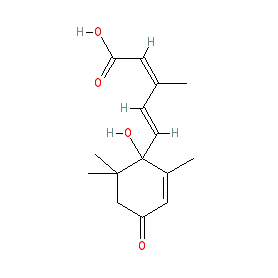|
Synonyms: (+/-)-(cis,trans)-abscisic acid | (+/-)-Abscisic acid | (RS)-Abscisic acid | ABA
Compound class:
Natural product or derivative
Comment: We show the compound without specified stereochemistry to represent racemic abscisic acid. The (1S)- or (+)-enantiomer (PubChem CID 12305886), is the naturally occurring and more active form of abscisic acid.
Abscisic acid activates human granulocytes [3] and stimulates insulin secretion by human and murine pancreatic β cells [1], via similar signalling pathways, that require a LANCL2-containing protein complex linked to a Gi protein, that ultimately leads to elevation of the intracellular Ca2+ concentration [8]. In cellular and animal models abscisic acid exerts anti-inflammatory [3-5] and antidiabetic [2,6] effects. Ligand Activity Visualisation ChartsThese are box plot that provide a unique visualisation, summarising all the activity data for a ligand taken from ChEMBL and GtoPdb across multiple targets and species. Click on a plot to see the median, interquartile range, low and high data points. A value of zero indicates that no data are available. A separate chart is created for each target, and where possible the algorithm tries to merge ChEMBL and GtoPdb targets by matching them on name and UniProt accession, for each available species. However, please note that inconsistency in naming of targets may lead to data for the same target being reported across multiple charts. ✖ |
|
|||||||||||||||||||||||||||||||||||
| Immunopharmacology Comments |
| Abscisic acid was originally described as a plant hormone. It has subsequently been identified as an endogenous cytokine in human granulocytes [3]. It has been reported to stimulate phagocytosis, ROS and NO production, chemotaxis, and chemokinesis. |








